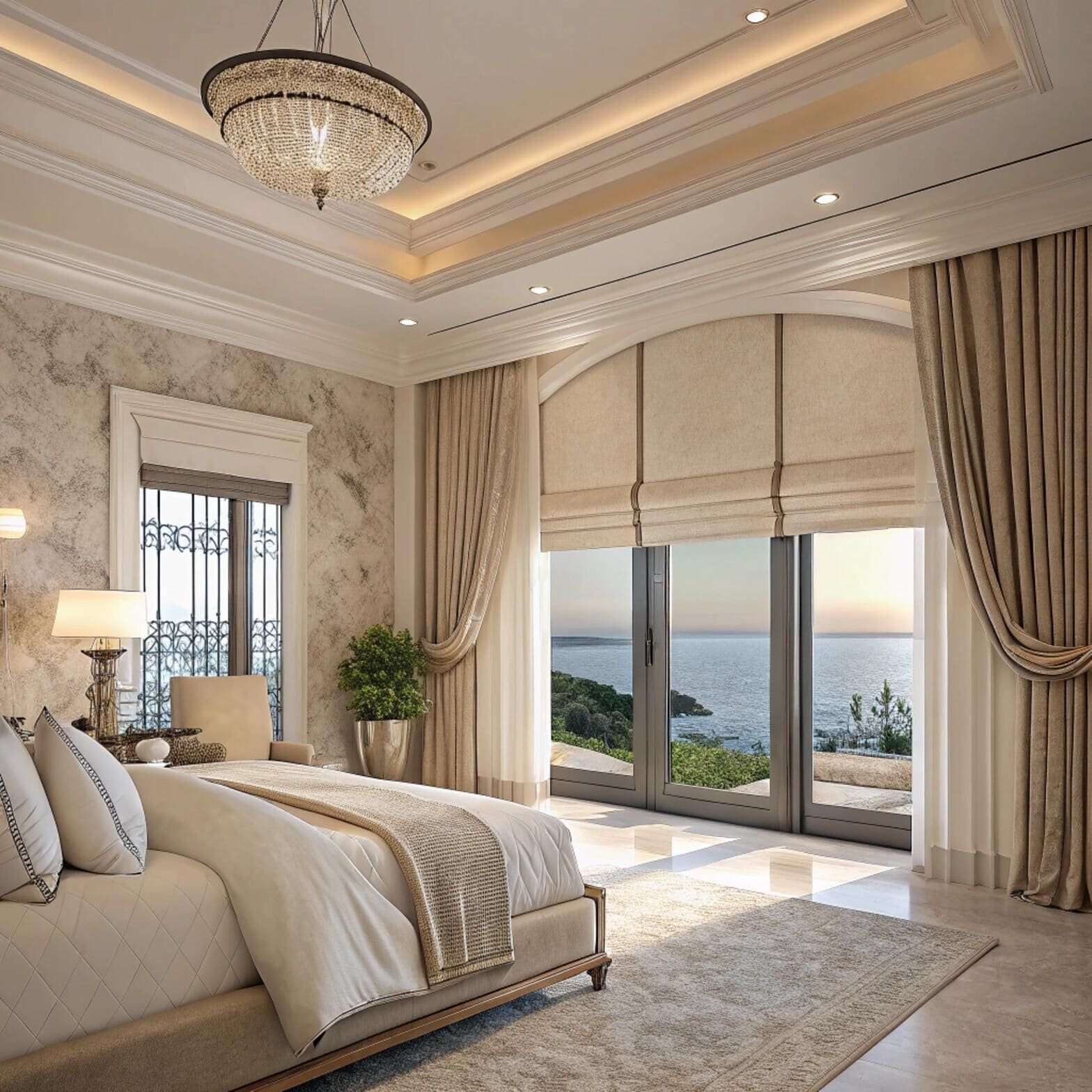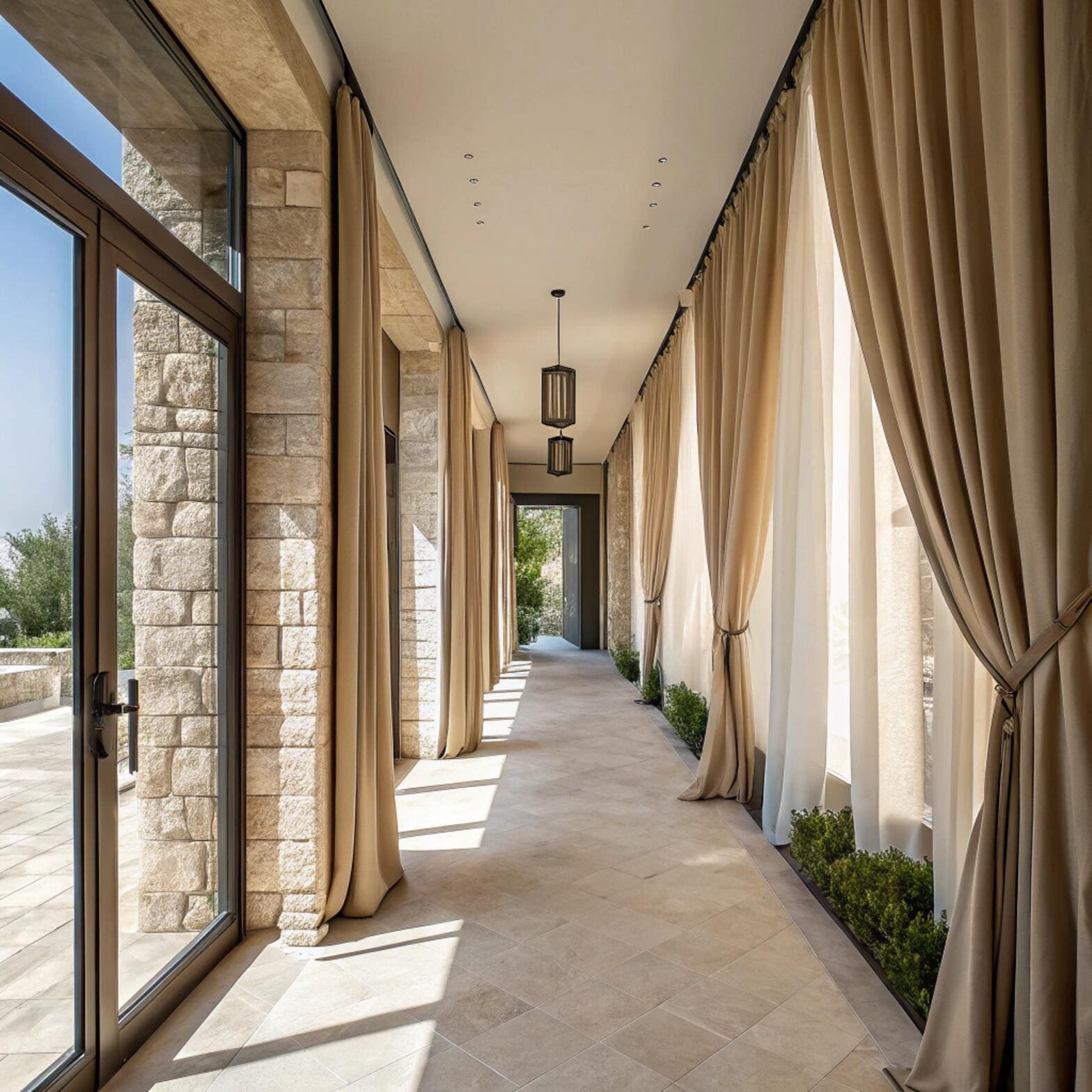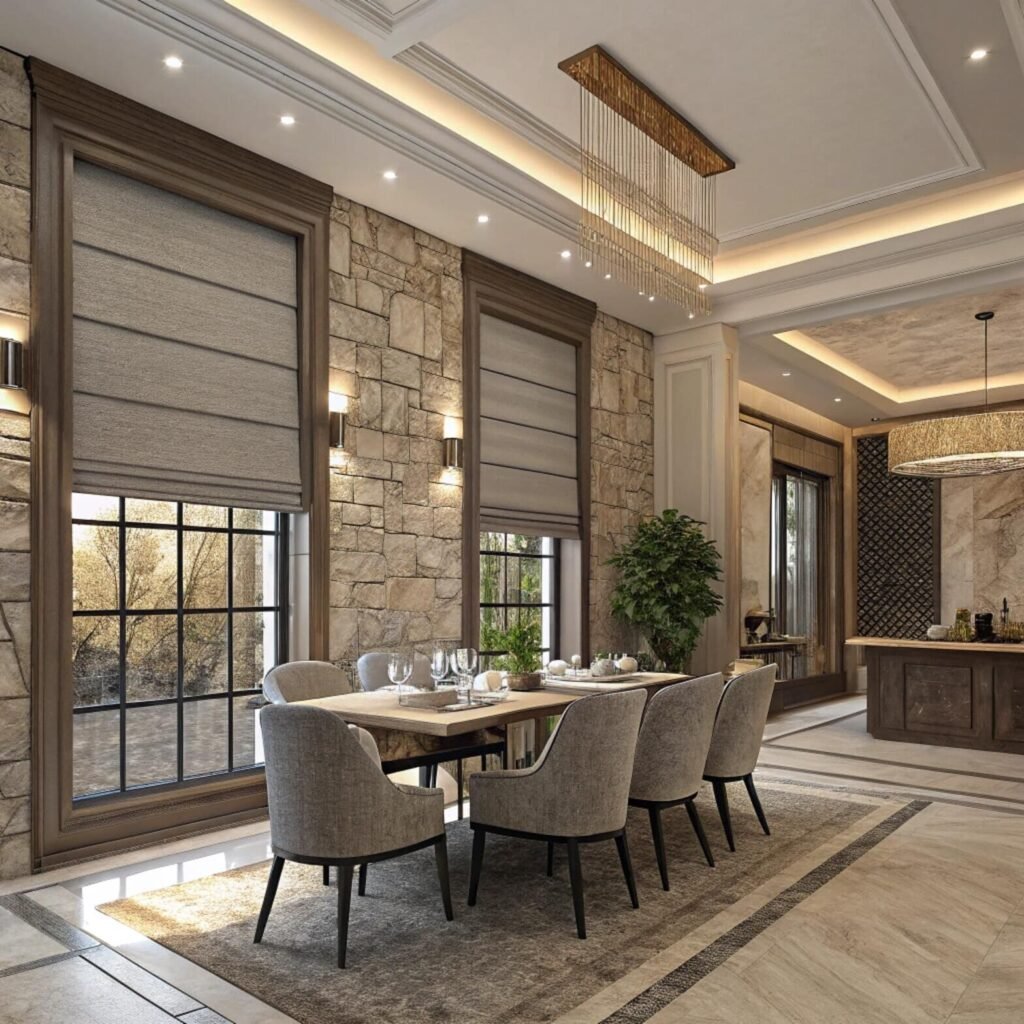Luxury villa window treatments[^1] demand elevated specifications. Generic residential solutions fail to deliver the sophistication, performance, and durability that high-end properties require for long-term value preservation.
2025 luxury villa window treatments emphasize automated integration[^2], premium materials[^3], and architectural coordination, requiring specialized design approaches that balance aesthetic excellence with advanced functionality.

I've been working with luxury villa projects across three continents this year. The expectations for window treatments have evolved beyond simple privacy and light control to encompass smart home integration, energy performance, and architectural statement-making.
How can I make my windows look luxurious?
Luxury window aesthetics require strategic layering, premium material selection, and architectural integration. Surface-level upgrades cannot achieve the sophisticated appearance that defines high-end residential environments and property values.
Luxury window appearance requires motorized layered systems, custom-sized installations, premium fabric selections, and coordinated hardware finishes that integrate seamlessly with architectural elements and interior design schemes.

Luxury Design Principles and Implementation Strategies
Creating luxurious window appearances demands understanding the visual and functional elements that distinguish high-end installations from standard residential treatments. My work with luxury villa projects across Malibu, Hamptons, and European estates reveals specific design principles that consistently deliver sophisticated results.
Proportion and Scale Mastery: Luxury windows require treatments sized to architectural proportions rather than standard residential dimensions. Floor-to-ceiling installations create vertical emphasis that enhances room height perception and architectural grandeur. Custom sizing eliminates the residential appearance of standard widths, with treatments extending 12-18 inches beyond window frames horizontally and mounting 6-12 inches above openings. This approach costs 25-35% more than standard sizing but transforms the visual impact dramatically.
Layering System Architecture: Premium installations utilize sophisticated layering that combines multiple treatment types for maximum versatility and visual depth. The most effective luxury approach layers motorized cellular shades for insulation and privacy with decorative panels or drapery for aesthetic impact. Roman shades coordinate with side panels for formal dining rooms, while automated blinds integrate with sheer curtains for master suites. Each layer serves specific functions while contributing to overall design sophistication.
Material Quality Hierarchy: Luxury installations demand materials that demonstrate premium quality through visual inspection and tactile experience. Natural silk fabrics, hand-woven linens, and premium wool blends provide the tactile luxury that defines high-end spaces. Hardware selections require solid brass, stainless steel, or custom bronze finishes rather than plastic or hollow alternatives. Thread counts above 200 for fabrics and solid metal construction for hardware components separate luxury installations from residential alternatives.
| Luxury Element | Standard Approach | Premium Approach | Investment Difference | Visual Impact |
|---|---|---|---|---|
| Sizing | Window dimension | Architectural proportion | +25-35% | Dramatic enhancement |
| Materials | Synthetic blends | Natural premium fibers | +60-80% | Tactile luxury |
| Hardware | Hollow/plastic | Solid metal custom | +100-150% | Refined detailing |
| Operation | Manual/basic motor | Silent automation | +200-300% | Seamless function |
Architectural Integration Strategy: The most successful luxury installations appear as integral architectural elements rather than applied treatments. This requires coordination with millwork, lighting design, and structural elements during planning phases. Crown molding integration, recessed mounting systems, and coordinated electrical planning create seamless appearances that distinguish luxury installations. Custom valances and cornices designed to match architectural details provide finished appearances that elevate overall room sophistication.
Automation and Control Sophistication: Luxury villa occupants expect silent, precise operation that responds to lifestyle patterns automatically. Premium motor systems operate at sound levels below 35 decibels while providing precise positioning control. Smart home integration allows voice control, smartphone operation, and programmed scenes that coordinate window treatments with lighting and climate systems. These capabilities require investment in control systems ranging from $150-350 per window but deliver the effortless operation expected in luxury environments.
What window treatments never go out of style?
Timeless window treatment design principles transcend temporary trends while maintaining relevance across decades. Understanding these enduring elements enables investment in treatments that preserve value and aesthetic appeal through multiple design cycles.
Classic Roman shades, tailored drapery panels, and sophisticated blind systems with quality hardware maintain design relevance across decades when executed with premium materials and proper proportions.

Timeless Design Elements and Longevity Factors
Identifying truly timeless window treatment styles requires analyzing design elements that have maintained appeal across multiple decades and cultural shifts. My analysis of luxury residential projects spanning 50+ years reveals specific characteristics that ensure long-term design relevance and property value preservation.
Classical Proportional Systems: Roman shades represent the most enduring window treatment style, maintaining popularity across centuries due to their architectural integration and functional versatility. The horizontal fold pattern creates visual weight that anchors window openings while providing complete privacy and light control. Premium Roman shade installations using natural fabrics like linen or cotton maintain relevance indefinitely when proportioned correctly. Installation costs range from $150-400 per window depending on fabric selection and motorization options.
Tailored Drapery Principles: Full-length drapery panels hung from ceiling-mounted hardware create timeless elegance that adapts to changing interior styles through fabric and hardware updates. The key to longevity lies in classic proportions: panels measuring 2.5-3 times window width for proper fullness, and lengths extending to floor level or slightly beyond. Custom drapery using premium fabrics costs $200-600 per window but provides decades of service when properly maintained.
Sophisticated Blind Systems: High-quality blind systems with premium materials and hardware maintain design relevance through superior craftsmanship and classic aesthetics. Natural wood blinds with furniture-grade finishes, aluminum blinds with architectural powder coating, and premium cellular systems provide timeless functionality. The key to longevity lies in quality construction and maintenance rather than trendy colors or patterns.
| Timeless Treatment | Longevity Factors | Investment Level | Maintenance Requirements | Style Adaptability |
|---|---|---|---|---|
| Roman Shades | Classical proportions | $150-400/window | Annual professional cleaning | High |
| Tailored Drapery | Premium fabrics/hardware | $200-600/window | Periodic fabric refresh | Very high |
| Quality Blinds | Superior construction | $100-350/window | Regular cleaning/adjustment | Moderate |
| Shutters | Architectural integration | $300-800/window | Minimal maintenance | High |
Hardware and Mounting Evolution: Timeless installations invest in superior hardware that maintains operation and appearance over decades. Solid brass, stainless steel, and bronze hardware develops attractive patina rather than showing wear. Traditional mounting methods using quality brackets and proper installation techniques prevent sagging and operational problems that plague inferior installations. Premium hardware costs 3-5 times standard alternatives but delivers proportional longevity and maintained appearance.
Fabric Selection for Longevity: Natural fiber fabrics including linen, cotton, wool, and silk provide the most enduring aesthetic appeal when properly maintained. These materials age gracefully, developing character rather than showing wear. Synthetic alternatives may offer initial cost savings but typically require replacement within 5-7 years compared to 15-20 years for premium natural materials. Color selection focusing on neutral tones and classic patterns ensures compatibility with evolving interior design preferences.
Adaptability and Refresh Strategies: Truly timeless treatments provide frameworks that accommodate style updates through component changes rather than complete replacement. Drapery panels can be refreshed with new fabrics while retaining hardware and proportional systems. Roman shade mechanisms accept new fabrics as interior styles evolve. This adaptability preserves initial investment while maintaining contemporary relevance through minor updates every 8-12 years.
What is the best window treatment for high windows?
High window applications present unique challenges requiring specialized solutions for operation, maintenance, and aesthetic integration. Standard residential approaches fail to address the practical and design requirements of elevated installations in luxury villa environments.
Motorized cellular systems, automated drapery tracks, and custom Roman shade installations provide optimal solutions for high windows, eliminating manual operation challenges while maintaining sophisticated aesthetics.

High Window Solution Architecture and Performance Analysis
High window installations in luxury villas require specialized engineering approaches that address operational accessibility, aesthetic proportions, and long-term maintenance requirements. My experience with cathedral ceilings, clerestory windows, and multi-story installations provides clear guidance for optimal high window treatment solutions.
Motorization Requirements and Selection: High windows above 8 feet require motorized operation for practical accessibility and safety compliance. Premium motor systems designed for luxury applications operate at noise levels below 35 decibels while providing precise positioning control and extended operational life. Somfy and Lutron represent the gold standard for high-end installations, offering 10-15 year warranties and smart home integration capabilities. Battery-powered systems eliminate electrical installation complexity for retrofit applications, while hardwired systems provide unlimited operation and integration with building automation systems.
Structural Load Considerations: High window treatments experience greater wind loads and gravitational stress compared to standard installations. Custom engineering analysis determines mounting requirements for treatments spanning large openings or installed at significant heights. Steel mounting systems may be required for installations exceeding 12 feet in width or 20 feet in height. Proper structural analysis and mounting system design prevents operational failures and safety hazards while maintaining aesthetic integration.
Installation and Service Access: High window installations require specialized equipment and safety protocols that affect both initial installation costs and ongoing maintenance expenses. Scaffolding or lift equipment adds $200-500 to installation costs depending on access complexity. Maintenance access planning during design phases prevents costly service calls and ensures long-term operability. Some luxury installations incorporate service access considerations into architectural design, including permanent access platforms or service corridors.
| Height Category | Recommended Solution | Motor Requirements | Installation Complexity | Annual Maintenance |
|---|---|---|---|---|
| 8-12 feet | Motorized cellular/roman | Battery or hardwired | Moderate | Standard |
| 12-16 feet | Automated drapery/blinds | Hardwired preferred | High | Professional required |
| 16-20 feet | Custom engineered systems | Hardwired only | Very high | Specialized service |
| 20+ feet | Architectural integration | Building automation | Extreme | Professional contracts |
Aesthetic Proportion Management: High windows require careful proportional analysis to maintain visual balance within room architecture. Treatments that appear appropriate at standard heights may seem inadequate when scaled to cathedral ceilings or clerestory applications. Width-to-height ratios, mounting positions, and material selection require adjustment for optimal visual impact. Professional design consultation becomes essential for installations exceeding standard residential scales.
Wind Load and Environmental Factors: High windows, particularly in multi-story villa applications, experience significant wind loads that affect treatment selection and mounting requirements. Coastal installations face additional challenges from salt air and extreme weather conditions. Material selection must consider UV exposure, thermal cycling, and structural stress factors that intensify with elevation. Cellular systems and roman shades generally provide better wind resistance compared to drapery installations.
Integration with Architectural Systems: High window treatments in luxury villas often require coordination with lighting, HVAC, and security systems. Automated systems can integrate with daylight harvesting controls, security monitoring, and climate management for optimal building performance. This integration requires planning during construction phases and affects both initial costs and long-term operational efficiency.
Conclusion
2025 luxury villa window treatments demand integrated approaches combining premium materials, advanced automation, and architectural coordination for enduring sophistication and optimal performance in high-end residential environments.
Extended FAQ Section
How much should I budget for luxury villa window treatments in 2025?
Luxury villa window treatment budgets vary significantly based on automation level, material quality, and custom requirements, with comprehensive installations typically ranging from $200-800 per window for premium solutions. Basic luxury installations with quality materials and simple motorization cost $200-350 per window, while fully automated smart home integrated systems range $400-600 per window. Ultra-premium installations with custom fabrics, architectural integration, and sophisticated automation reach $600-800 per window. Large villa projects benefit from economies of scale, reducing per-window costs by 15-25% for installations exceeding 30 windows. Additional costs include design consultation ($150-300 per hour), engineering analysis for complex installations ($1,500-5,000 per project), and specialized installation services ($50-150 per window premium). Maintenance contracts for automated systems cost $100-300 annually per window but prevent expensive service calls and extend equipment life. Quality installations provide 15-20 year service life with proper maintenance, making total cost of ownership competitive with frequent replacement of lower-quality alternatives. Professional design and specification services ensure optimal budget allocation and prevent costly mistakes that compromise both function and aesthetics.
What smart home features should luxury window treatments include in 2025?
2025 luxury window treatments require comprehensive smart home integration including voice control, automated scheduling, environmental sensors, and energy management capabilities that enhance both convenience and property value. Premium installations incorporate Amazon Alexa, Google Assistant, and Apple HomeKit compatibility for seamless voice operation and smartphone control. Astronomical timers automatically adjust treatments based on sunrise/sunset times and seasonal variations, while photosensors respond to changing light conditions throughout the day. Integration with HVAC systems optimizes energy efficiency by coordinating window treatments with heating and cooling schedules. Security integration allows treatments to simulate occupancy during travel and coordinate with alarm systems for enhanced privacy. Weather sensors automatically protect treatments during storms and high winds while maximizing natural light during optimal conditions. Energy monitoring features track heating and cooling savings, providing ROI documentation for homeowners. Geofencing capabilities detect arrival and departure patterns, adjusting treatments automatically for optimal comfort and energy efficiency. Professional installation and programming services cost $500-1,500 per room but deliver sophisticated automation that distinguishes luxury properties. Annual software updates and cloud subscriptions range $100-300 but ensure continued compatibility and feature enhancement as technology evolves.
How do I maintain window treatments in luxury villas to preserve their appearance?
Luxury villa window treatment maintenance requires systematic approaches tailored to premium materials and sophisticated mechanisms that preserve both aesthetic appeal and functional performance over decades of service. Natural fabric treatments including silk, linen, and wool require professional cleaning every 12-18 months using specialized techniques that prevent shrinkage and color fading. Motorized systems need annual lubrication and calibration to maintain silent operation and precise positioning accuracy. Quarterly inspection schedules identify early wear signs before they compromise function or appearance. UV protection through window films or protective coatings prevents fabric degradation and color fading, particularly important for south-facing installations. Proper environmental controls including humidity management and temperature stability prevent material degradation and mechanical stress. Documentation of maintenance activities supports warranty claims and helps optimize replacement scheduling. Professional maintenance contracts cost $150-400 annually per room but ensure optimal performance and preserve manufacturer warranties. Emergency service protocols address weather damage, mechanical failures, or unexpected issues promptly to prevent secondary damage. Seasonal maintenance includes deep cleaning, hardware inspection, and performance verification to prepare treatments for changing environmental conditions. Preventive replacement of wear components every 5-7 years maintains optimal function and prevents costly emergency repairs that could damage premium materials.
Elevate Your Villa with Luxury Window Treatment Solutions
Transform your high-end villa with window treatments that deliver uncompromising luxury, advanced automation, and architectural integration. Our luxury residential specialists provide comprehensive design consultation, premium material selection, and sophisticated installation services tailored to discerning villa owners.
Contact our luxury residential team for personalized consultation, premium material samples, and detailed project proposals at info@velablinds.com.
---
[^1]: Explore this resource to discover the latest trends and innovations in luxury villa window treatments that enhance sophistication and functionality.
[^2]: Learn how automated integration can elevate the functionality and aesthetics of luxury window treatments, making them a must-have for modern homes.
[^3]: Discover the importance of premium materials in luxury window treatments and how they contribute to durability and visual appeal.Partner with VelaBlinds for Your Next Project
Smart window treatments shouldn't be complicated. After working with 500+ distributors and contractors worldwide, I've streamlined the process to get you quality products, competitive pricing, and reliable support - every time.
Why project professionals choose VelaBlinds:
- ✅ Fast, Accurate Quotes - Detailed specs and pricing within 24 hours
- ✅ Transparent Pricing - No hidden fees, volume discounts clearly outlined
- ✅ Quality Assurance - Direct partnerships with certified OEM manufacturers
- ✅ Project Support - Dedicated account manager from quote to delivery
Start your next project:
📧 Quick Quote: Send your requirements to info@velablinds.com
📱 Direct Contact: WhatsApp +86 137 2012 8317
🌐 Browse Solutions: https://velablinds.com/
📁 Product Resources: Access spec sheets, catalogs & project files
Jimmy Chen, Founder
"I built VelaBlinds to solve the real challenges I faced as a project buyer - long lead times, unclear specs, and unreliable suppliers. Let's discuss how we can power your projects with smarter blinds."
Serving distributors and contractors across North America, Europe, and Australia since 2018.




